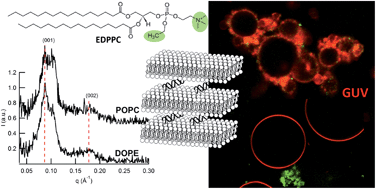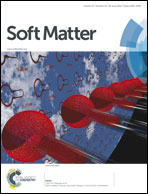Biocompatible cationic lipids for the formulation of liposomal DNA vectors†
Abstract
Ethylphosphocholine lipids are highly biocompatible cationic amphiphiles that can be used for the formulation of liposomal DNA vectors, with negligible toxic effects on cells and organisms. Here we report the characterization of EDPPC (1,2-dipalmitoyl-sn-glycero-O-ethyl-3-phosphocholine chloride) liposomes, containing two different zwitterionic helper lipids, POPC (1-palmitoyl-2-oleoyl-sn-glycero-3-phosphocholine) and DOPE (1,2-dioleoyl-sn-glycero-3-phosphoethanolamine). Depending on the nature of the helper lipid, a phase separation in the bilayer is found at room temperature, where domains enriched in the cationic component coexist in a relatively large temperature range with regions where the zwitterionic lipids are predominant. We studied DNA complexation, the internal structure of lipoplexes and their docking and fusogenic ability with model target bilayers. The structural and functional modifications caused by DNA binding were studied using Dynamic Light Scattering (DLS), zeta potential, and small and wide angle X-ray scattering (SAXS-WAXS) measurements, while the interaction with membranes was assessed by using Giant Unilamellar Vesicles (GUVs) as model target bilayers. The results presented establish a connection between the physicochemical properties of lipid bilayers, and in particular of lipid demixing, with the phase state of the complexes and their ability to interact with model membranes.


 Please wait while we load your content...
Please wait while we load your content...